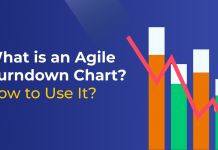
Scaled Agile Framework ®, also identified as SAFe ®, is a methodology of company-scale development developed by Scaled Agile, Inc. In a templated framework, Secure incorporates Lean and Agile concepts. SAFe’s supporters say it offers a substantial improvement in employee participation, improved efficiency, shorter selling times, and better output quality.
What is Scaled Agile Framework (SAFe)?
Scaled Agile Platform (SAFe) is an online learning base that is publicly accessible, allowing you to implement lean-agile strategies at the business level. It offers a comfortable and lightweight app development experience. It is a collection of entities and process models designed to direct businesses to transform lean and agile processes. It is split into three parts: Team, Program, and Portfolio.
Listed below are some facts related to SAFe:
- Lean-Agile applications and frameworks are introduced at the business level
- It is founded based on Lean and Agile principles
- It offers comprehensive instructions for business, value line, initiative, and teamwork at the company
- It is structured to address all members ‘ needs within an organization
- SAFe was first introduced in the area, which was introduced in books by Dean Leffingwell
- The first public update in 2011 is Version 1.0
- The most recent update is 4.6, released in October 2018
- It offers guidelines for Work at the levels of the business portfolio, value line, software, and staff
The Pros and Cons of SAFe?
Pros
- Helps inter-functional teams to communicate more efficiently
- Allows companies to get more accountability
- Brings all facets of a project into line with broader market priorities
Cons
- Some consider that the System is not strictly agile since it needs so much initial preparation and method specification
- It also takes something of a top-down strategy instead of a squad strategy
Core Values of SAFe
SAFe focuses on four core and fundamental values:
Alignment
The global focus is inherently more beneficial than the local guide. Individuals on a team from SAFe should value the goals of the section above personal duties and functions. Extending that, Agile Release Trains members should emphasize vision and program goals over team goals. ARTs should focus on the objectives of Value Stream over those of ART. Value Streams focuses on value contributions towards the portfolio of companies. Eventually, management should start setting up a mission but should do so with the fewest possible restrictions.
Built-in Quality
SAFe includes several built-in quality solutions to ensure each component is up to the same high-quality standard within each incremental build.
Transparency
The challenge of large-scale development. Transparency builds confidence throughout the project by sharing facts and openly progressing across all levels. This extra level of trust allows decentralized decision-making and new employee empowerment.
Program execution
Every other Agile Release Train should deliver value predictably. The SAFe Program Level provides duties and guidance to assist with value creation in wavelengths ranging roles within ARTs.
Now that you know what is Scaled Agile Framework, let us explore how it works?
How does SAFe Work?
Organizations that are ready to implement SAFe generally have sponsorship at the executive level, a vital purpose for change, and a solid Scrum foundation.
Scaled Agile, Inc. provides a roadmap for implementing SAFe, which contains detailed steps on how to get started and set up the organization for broad portfolio adoption. The 12 Secure Deployment Measures include:
- Achieving the tipping point
- Trains agents of lean-agile transition
- Train administrators, executives, and leaders
- Build a lean-agile core of excellence
- Identify merit sources (Agile Release Trains) and ARTs
- Build a Plan of Execution
- Prepare for ART startup
- Train teams and start an ART
- Coach the implementation of an ART
- Start more ARTs and fluxes of importance
- Enlarge portfolio
- Keep on and boost
Should You Use the Scaled Agile Framework?
SAFe is the most prominent among corporate organizations as all of its dimensions are focused on reducing common problems facing teams as agile is scaled.
Suppose the enterprise is only starting to turn to agile. In that case, SAFe may be a feasible choice to fill the gap because of its more prescriptive approach than, say, Structured Agile (DA), which provides greater consistency and versatility but still allows an organization to grasp the agile concept already thoroughly.
However, it is worth noting that SAFe’s top-down approach to decision-making and project management can negate some of the fundamental agile principles — such as group control, adaptability, and less defined roles — that may have drawn the team agile in the first place.
SAFe Implementation
Because of SAFe’s sheer scale and breadth, a proper implementation may be quite overwhelming, especially starting. Although a complete description of the introduction of Secure will take tens of thousands of words — and since more comprehensive material is available on the official website — here we will cover a summary of the introduction:
Train Implementers
Most organizations would need a mix of internal and external trainers and coaches due to the sheer complexity and difficulty they need when implementing Healthy. These individuals should be able to effectively instruct and distribute Healthy strategies to those around the enterprise.
Train Executives, Managers, and Leaders
Implementers’ initial bunch must first concentrate on educating all executives, managers, and leaders. The method will become much easier for the entire enterprise until these basic team members grasp the Lean-Agile mentality, Secure key concepts, and delivery strategies.
Train Teams
Ideally, people can be grouped into Agile Teams, which should then teach them all on the different concepts of Lean, Agile, and Secure.
Launch Agile Release Trains
Eventually, after the enterprise has been adequately organized, it’s time to organize Agile Teams into ARTs, and then create templates for mission preparation, task implementation, task increment preparation, and all the other elements needed for an effective Agile Release Train.
Summary: Key Points for Take-away
- SAFe is an industry-proven, value-focused approach for Enterprise-level Agile scaling
- It asks questions like “How do we organize?,” “How do we spend?” and “How do we become architecture and DevOps multidisciplinary?”
- SAFe lets large corporate teams achieve the overall priorities of an enterprise, not just the individual aims of a group
- The System provides the opportunity to sustain and develop a standardized value distribution approach
- The Secure model has three / four layers centralizing an organization’s strategic concepts
- Centralized policy, coupled with the implementation of decentralized agile growth
I hope this article on ‘What is Scaled Agile Framework (SAFe)?’ helped you guys. For more information on SAFe and other Agile methodologies, you should consider pursuing a Agile certification course at Invensis Learning. Some of the popular SAFe certification courses that individuals and enterprise teams can take up are:
SAFe for Teams Certification Training
Leading SAFe Certification Training














